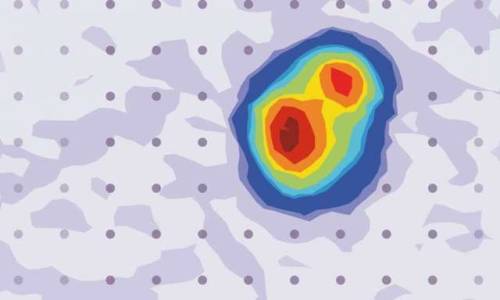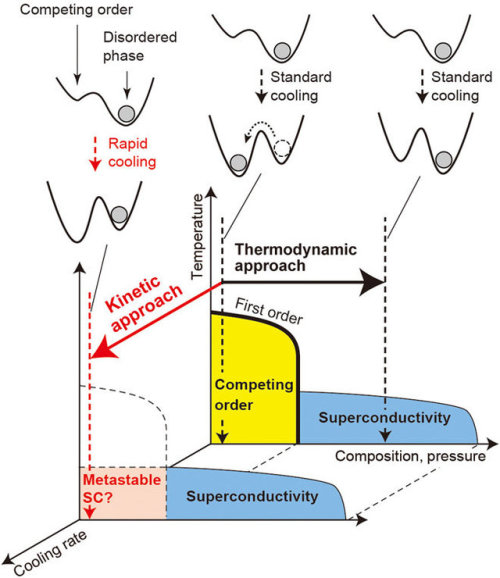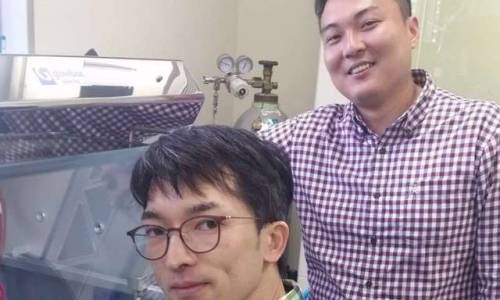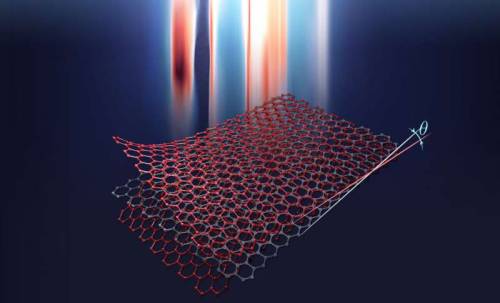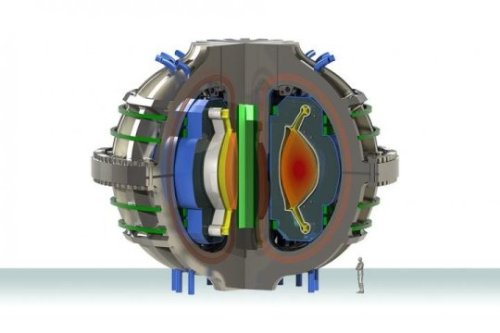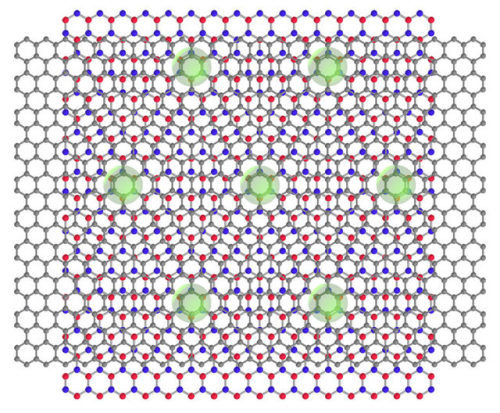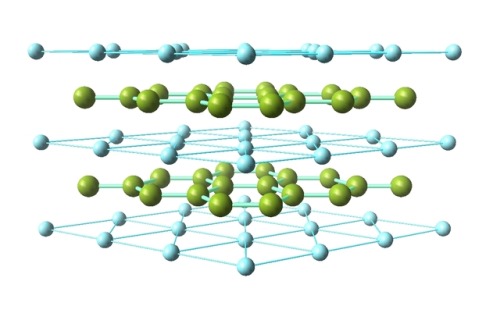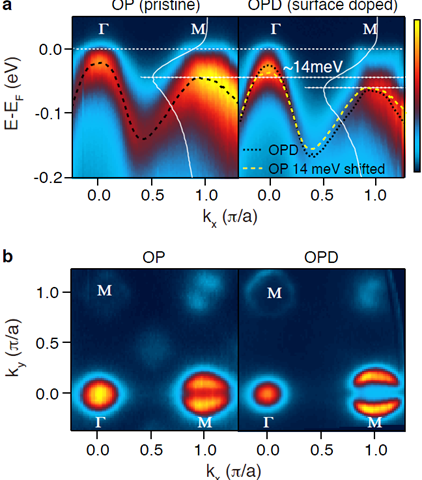#superconductors
A mysterious insulating phenomenon in a superconductor
Leiden physicist Milan Allan and his group have discovered an apparent paradox within a material that has zero electrical resistance. They report trapped charges, although charges should, in theory, keep flowing in the absence of resistance. The discovery could provide a missing piece of one of the big puzzles in physics today—high-temperature superconductivity. The results are published in Nature Physics.
A material can either be insulating or conductive. In an insulator, an extra electron will get trapped. Thus, no electric current flows in insulators. In a conductor, extra electrons will immediately flow. The more conductive the material is, the faster the electrons will flow.
The research group of Leiden physicist Milan Allan was therefore surprised to discover charge trapping in a material with zero resistance. Charge trapping is supposed to be a telltale sign of an insulator. Together with Leiden theoretical physicist Jan Zaanen, Allan’s group found that the phenomenon could unravel a longstanding mystery about charge transport in a family of materials called cuprates. These poorly understood materials have no resistance, even at relatively high temperatures, and are therefore labeled high-temperature superconductors. The mechanism behind those is one of the big mysteries in physics today.
Post link
Forcing a metal to be a superconductor via rapid chilling
A team of researchers with the RIKEN Center for Emergent Matter Science and The University of Tokyo, both in Japan, has found a way to force a metal to be a superconductor by cooling it very quickly. In their paper published on the open access site, Science Advances, the group describes their process and how well it worked.
Scientists around the world continue to seek a material that behaves as a superconductor at room temperature—such a material would be extremely valuable because it would have zero electrical resistance. Because of that, it would not increase in heat as electricity passed through it, nor lose energy. Scientists have known that cooling some materials to very cold temperatures causes them to be superconductive. They have also known that some metals fail to do so because they enter a “competing state.” In this new effort, the researchers in Japan have found a way to get one such non-cooperative metal to enter a superconductive state anyway—and to stay that way for over a week.
Post link
New fiber optic temperature sensing approach to keep fusion power plants running
The pursuit of fusion as a safe, carbon-free, always-on energy source has intensified in recent years, with a number of organizations pursuing aggressive timelines for technology demonstrations and power plant designs. New-generation superconducting magnets are a critical enabler for many of these programs, which creates growing need for sensors, controls, and other infrastructure that will allow the magnets to operate reliably in the harsh conditions of a commercial fusion power plant.
A collaborative group led by Department of Nuclear Science and Engineering (NSE) doctoral student Erica Salazar recently took a step forward in this area with a promising new method for quick detection of a disruptive abnormality, quench, in powerful high-temperature superconducting (HTS) magnets. Salazar worked with NSE Assistant Professor Zach Hartwig of the MIT Plasma Science and Fusion Center (PSFC) and Michael Segal of spinout Commonwealth Fusion Systems (CFS), along with members of the Swiss CERN research center and the Robinson Research Institute (RRI) at Victoria University in New Zealand to achieve the results, which were published in the journal Superconductor Science and Technology.
Stanching quench
Quench occurs when part of a magnet’s coil shifts out of a superconducting state, where it has no electrical resistance, and into a normal resistive state. This causes the massive current flowing through the coil, and stored energy in the magnet, to quickly convert into heat, and potentially cause serious internal damage to the coil.
Post link
Researchers discover a novel layered superconductor based on tin and arsenic
The layered superconducting material is characterized by a crystal structure in which a SnAs layer (wherein Sn and As are two-dimensionally bonded to develop superconductivity) and a Na layer (the spacer layer) are alternately laminated. Considering that such a layered structure is similar to that of a cuprate- or iron-based high-temperature (high-Tc) superconductor, it is possible that in SnAs-based layered materials, superconductivity is developed as a result of the unconventional pairing mechanism.
The research group of Yoshikazu MIZUGUCHI (Associate Professor) and Yosuke GOTO (Project Researcher) specializes in the discovery of two-dimensional layered structures—various materials can be designed by laminating different kinds of layers. As an example, in 2012, this research group also reported the discovery of novel layered superconducting material systems, Bi4O4S3 and LaO1-xFxBiS2, based on bismuth (Bi) and sulfur (S). To add, as the two-dimensional crystal structure gives rise to a low-dimensional electronic state, researchers are actively studying unique quantum phenomena such as high-temperature superconductivity.
Regarding NaSn2As2, Mizuguchi asserts that although the transition temperature of 1.3 K (-271.85°C) is not exactly high, it is anticipated that new materials will be developed based on the SnAs conductive layer, thereby clarifying the mechanisms underlying the increase of the transition temperature as well as those responsible for high-transition-temperature superconductivity.
Post link
Scientists use trilayer graphene to observe more robust superconductivity
In 2018, the physics world was set ablaze with the discovery that when an ultrathin layer of carbon, called graphene, is stacked and twisted to a “magic angle,” that new double layered structure converts into a superconductor, allowing electricity to flow without resistance or energy waste. Now, in a literal twist, Harvard scientists have expanded on that superconducting system by adding a third layer and rotating it, opening the door for continued advancements in graphene-based superconductivity.
The work is described in a new paper in Science and can one day help lead toward superconductors that operate at higher or even close to room temperature. These superconductors are considered the holy grail of condensed matter physics since they would allow for tremendous technological revolutions in many areas including electricity transmission, transportation, and quantum computing. Most superconductors today, including the double layered graphene structure, work only at ultracold temperatures.
“Superconductivity in twisted graphene provides physicists with an experimentally controllable and theoretically accessible model system where they can play with the system’s properties to decode the secrets of high temperaturesuperconductivity,” said one of the paper’s co-lead authors Andrew Zimmerman, a postdoctoral researcher in working in the lab of Harvard physicist Philip Kim.
Post link
Scientists explain the low-temperature anomaly in superconductors
An international group of scientists, including a researcher from Skoltech, has completed an experimental and theoretical study into the properties displayed by strongly disordered superconductors at very low temperatures. Following a series of experiments, the scientists developed a theory that effectively describes the previously inexplicable anomalies encountered in superconductors. The results of the study were published in Nature Physics.
The phenomenon of superconductivity was discovered in 1911 by a group of scientists led by Dutch physicist Heike Kamerlingh Onnes. Superconductivity means complete disappearance of electrical resistance in a material when it is cooled down to a specific temperature, resulting in the magnetic field being forced out from the material. Of particular interest to scientists are strongly disordered superconductors whose atoms do not form crystal lattices. From a practical standpoint, strongly disordered superconductors hold great potential for quantum computer development.
Post link
A new path to solving a longstanding fusion challenge
Novel design could help shed excess heat in next-generation fusion power plants
A class exercise at MIT, aided by industry researchers, has led to an innovative solution to one of the longstanding challenges facing the development of practical fusion power plants: how to get rid of excess heat that would cause structural damage to the plant.
The new solution was made possible by an innovative approach to compact fusion reactors, using high-temperature superconducting magnets. This method formed the basis for a massive new research program launched this year at MIT and the creation of an independent startup company to develop the concept. The new design, unlike that of typical fusion plants, would make it possible to open the device’s internal chamber and replace critical components; this capability is essential for the newly proposed heat-draining mechanism.
The new approach is detailed in a paper in the journal Fusion Engineering and Design, authored by Adam Kuang, a graduate student from that class, along with 14 other MIT students, engineers from Mitsubishi Electric Research Laboratories and Commonwealth Fusion Systems, and Professor Dennis Whyte, director of MIT’s Plasma Science and Fusion Center, who taught the class.
Post link
A graphene superconductor that plays more than one tune: Researchers at Berkeley Lab have developed a tiny toolkit for scientists to study exotic quantum physics
Researchers at the U.S. Department of Energy’s Lawrence Berkeley National Laboratory (Berkeley Lab) have developed a graphene device that’s thinner than a human hair but has a depth of special traits. It easily switches from a superconducting material that conducts electricity without losing any energy, to an insulator that resists the flow of electric current, and back again to a superconductor - all with a simple flip of a switch. Their findings were reported today in the journal Nature.
[…]
“Usually, when someone wants to study how electrons interact with each other in a superconducting quantum phase versus an insulating phase, they would need to look at different materials. With our system, you can study both the superconductivity phase and the insulating phase in one place,” said Guorui Chen, the study’s lead author and a postdoctoral researcher in the lab of Feng Wang, who led the study. Wang, a faculty scientist in Berkeley Lab’s Materials Sciences Division, is also a UC Berkeley physics professor.
Post link
Iron selenide film reveals clues about superconductivity
Through their study of two-dimensional iron selenide (FeSe) films, a research team has unlocked some intriguing clues about superconductivity.
Superconductors—materials that can transport electrons with no resistance—are a quantum phenomenon with numerous applications. They have fascinated physicists and engineers since their discovery more than 100 years ago, but the mechanisms of modern superconductors are still not fully understood and remain one of the most active areas of research in quantum materials.
Since it was discovered in 2012, FeSe in its three-atoms-thick monolayer form has received much attention from researchers for its unusual superconductive properties. In bulk form, it becomes a superconductor at 8 Kelvin, or -265 Celsius. As a monolayer, though, it starts superconducting at about 70 Kelvin, or 203 degrees below zero—still very chilly, but moving in the right direction. In a collaboration with the University of British Columbia, Yale researchers shed some light on behavior of electrons in this system, which could prove to be key to understanding superconductivity itself. The results are published in Nature Communications.
Post link
Ceramics: Magnesium diboride
Classified as a simple binary compound, magnesium diboride (MgB2) is also sometimes known as an intermetallic superconductor. It has a hexagonal crystal structure, which forms two-dimensional layers of boron in a graphite-like structure between the triangular layers of magnesium (as seen in the two images above).
MgB2‘s biggest claim to fame is its status as a relatively inexpensive superconductor. Among conventional superconductors (those that are phonon-mediated), it has one of the highest critical temperatures, at around 39 K. Though it had been known as a material to scientists for some time, its superconductivity was not discovered until 2001. Aside from being a high-temperature superconductor, MgB2 also has more than one superconducting energy gap, something theorized but rarely seen experimentally.
The bulk, polycrystalline form of the material can be easily made by exposing solid boron to magnesium vapor at high temperatures. Single crystals of the material are more difficult to form, but can be done so under high pressure. Thin films are often made through hybrid physical-chemical vapor deposition.
Applications (or possible applications) of MgB2 often take advantage of its superconductivity, such as in MRIs and tokamaks, but the material does have other suggested uses. The compound burns completely when ignited in oxygen, and so has been proposed for usage as a fuel in ramjets, or in blast-enhanced explosives and propellants.
Sources: ( 1 - image 3 ) (2) (3) (4) (5) (6)
Post link
Physicists advance high temperature superconducters for many potential applications
ByKim McDonald-
Physicists at UC San Diego have developed a new way to control the transport of electrical currents through high-temperature superconductors—materials discovered nearly 30 years ago that lose all resistance to electricity at commercially attainable low temperatures.
Their achievement, detailed in two separate scientific publications, paves the way for the development of sophisticated electronic devices capable of allowing scientists or clinicians to non-invasively measure the tiny magnetic fields in the heart or brain, and improve satellite communications.
“We believe this new approach will have a significant and far-reaching impact in medicine, physics, materials science and satellite communications,” said Robert Dynes, a professor of physics and former Chancellor of UC San Diego.
READ MORE ON UC SAN DIEGO
Ref: YBa2Cu3O7− δ superconducting quantum interference devices with metallic to insulating barriers written with a focused helium ion beam. Applied Physics Letters (2015) | http://dx.doi.org/10.1063/1.4922640
Post link
Atomic-level flyovers show how impact sites of high-energy ions pin potentially disruptive vortices to keep high-current superconductivity flowing. High-energy gold ions impact the crystal surface from above at the sites indicated schematically by dashed circles. Measurement of the strength of…
Enhanced electron doping on iron superconductors discovered
The Institute for Basic Science research team headed by the associate director of CCES, KIM Chang Young, presented the possibility of unifying theories to explain the working mechanism of iron- based superconductors.
Their research was published in Nature Materials on August 16th. Superconductors are a relatively new concept; they were brought to prominence in the late 80’s when two Nobel Prize winners discovered a new superconducting material. The basic principle of superconductivity arises when a superconducting material is cooled to a fairly low critical temperature allowing an electric current to flow without resistance.
Building on a Nobel Prize
The Nobel Prize winners reported their superconducting material - oxides which contain copper and rare earth metals - becomes a superconducting material below -250° Celsius, higher than the previous temperature of -269° Celsius. This led to a boom in developing similar materials for commercial use. Today’s research has moved on greatly; oxides are replaced with iron-based superconductors which are cheaper to mass produce and also permit a current to flow unabated. To understand the working mechanism of iron-based superconductors scientists have to significantly raise the transition temperatures to source the reason for the increase. Many researchers initially work on the assumption that the nesting effect is a dominant factor, especially in the case of pnictide superconductors {PSD}. Later, scientists discovered another type of superconductor, chalogenide superconductors {CSD}. Since it turned out that CSD is not subject to the nesting effect, the discovery of CSD generated controversy on the mechanism of their superconductivity. The nesting effect states when the surface temperature is increased, electrons become unstable thereby altering their properties both electrically and magnetically, allowing conductors to turn into superconductors.
Post link
What Happens Between the Sheets? Extremely-Promising Superconductor Surprises Everyone
‘Floating’ Graphene on a Bed of Calcium Atoms
Adding calcium to graphene creates an extremely-promising superconductor, but where does the calcium go?
Adding calcium to a composite graphene-substrate structure creates a high transition-temperature (Tc) superconductor.
In a new study, an Australian-led team has for the first time confirmed what actually happens to those calcium atoms: surprising everyone, the calcium goes underneath both the upper graphene sheet and a lower ‘buffer’ sheet, ‘floating’ the graphene on a bed of calcium atoms.
Superconducting calcium-injected graphene holds great promise for energy-efficient electronics and transparent electronics.
Post link
A tiny instrument to measure the faintest magnetic fields
Physicists at the University of Basel have developed a minuscule instrument able to detect extremely faint magnetic fields. At the heart of the superconducting quantum interference device are two atomically thin layers of graphene, which the researchers combined with boron nitride. Instruments like this one have applications in areas such as medicine, besides being used to research new materials.
To measure very small magnetic fields, researchers often use superconducting quantum interference devices, or SQUIDs. In medicine, their uses include monitoring brain or heart activity, for example, while in the earth sciences researchers use SQUIDs to characterize the composition of rocks or detect groundwater flows. The devices also have a broad range of uses in other applied fields and basic research.
The team led by Professor Christian Schönenberger of the University of Basel’s Department of Physics and the Swiss Nanoscience Institute has now succeeded in creating one of the smallest SQUIDs ever built. The researchers described their achievement in the scientific journal Nano Letters.
Discovery of the one-way superconductor, thought to be impossible
Associate professor Mazhar Ali and his research group at TU Delft have discovered one-way superconductivity without magnetic fields, something that was thought to be impossible ever since its discovery in 1911—up until now. The discovery, published in Nature, makes use of 2D quantum materials and paves the way toward superconducting computing. Superconductors can make electronics hundreds of times faster, all with zero energy loss. Ali: “If the 20th century was the century of semiconductors, the 21st can become the century of the superconductor.”
During the 20th century, many scientists, including Nobel Prize winners, have puzzled over the nature of superconductivity, which was discovered by Dutch physicist Kamerlingh Onnes in 1911. In superconductors, a current goes through a wire without any resistance, which means inhibiting this current or even blocking it is hardly possible—let alone getting the current to flow only one way and not the other. That Ali’s group managed to make superconducting one-directional—necessary for computing—is remarkable: one can compare it to inventing a special type of ice which gives you zero friction when skating one way, but insurmountable friction the other way.
Post link
After 15 Years of Research, Scientists Reveal the Fourth Signature of the Superconducting Transitions
The results cap 15 years of detective work aimed at understanding how these materials transition into a superconducting state where they can conduct electricity with no loss.
Researchers were ecstatic 35 years ago when a novel and exciting new class of superconducting materials was found.
These copper oxides or cuprates, like other superconductors, conducted electricity without resistance or loss when chilled below a specific degree – but at substantially larger temperatures than scientists had expected. This increased the possibility of having them to work at temperatures near to room temperature for perfectly efficient power lines and other uses.
Research quickly confirmed that they demonstrated two additional classic characteristics of the transition to a superconducting state. The material expelled magnetic fields as superconductivity occurred, allowing a magnet placed on a chunk of the material to hover above the surface. And during the transition, their heat capacity – the amount of heat required to raise their temperature by a certain amount – displayed a notable abnormality.
Post link
A single neuron in isolation cannot be said to possess memory, feelings, or consciousness. However, group many neurons together and the type of advanced information processing that takes place in the human brain suddenly appears. This suggests that perhaps each level in the micro-macro hierarchy…

